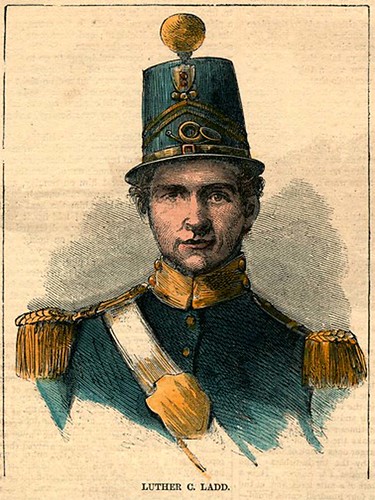April 19, 1861: The Baltimore Riot

Mural of Baltimore Riot of Apr 19, 1861 at Massachusetts State House
On this day 157 years ago, April 19, 1861, two young men from Lowell, Luther Ladd and Addison Whitney, were killed by hostile fire while serving in the Sixth Massachusetts Volunteer Infantry Regiment, making them, and two of their comrades – Sumner Needham of Lawrence and Charles Taylor of Boston – the first soldiers to die by hostile fire in the American Civil War.

Luther Ladd

Addison Whitney
The war would claim 725,000 lives, but because Ladd and Whitney were the first to die, the city of Lowell and the Commonwealth of Massachusetts would preserve their memories with a monument in front of Lowell City Hall, a monument that bears their names – the Ladd & Whitney Monument.
Here’s what happened:
After the South Carolina militia attacked and forced the surrender of the U.S. Army’s Fort Sumter, President Lincoln called for the northern states to mobilize 75,000 volunteer troops to come to Washington to help put down the rebellion. Although the United States had a regular army in existence, it was small and scattered at frontier outposts around the west, so Lincoln had to depend on state militia units, the National Guard of the day.
Among the first units to mobilize was the Sixth Regiment which was based in Lowell and contained 214 men from the city in its ranks. Traveling to Washington, DC, by train, as the regiment passed through Baltimore, a city with strong pro-Southern sympathies, the soldiers found their way blocked and were forced to dismount from the railroad cars and march through the city.
A large, angry crowd assaulted the men from Massachusetts, first with stones and bricks and then with gunfire. The men of the Sixth Regiment fired back. In the melee, Ladd, Whitney, Needham and Taylor were all killed and two dozen of their comrades were wounded. The soldiers returned fire, killing twelve of the rioters and wounding countless others.
After the fight, the survivors of the Sixth boarded a train for Washington and reached the city that afternoon, making them the first Northern troops to reach the national capital which was until then, was undefended and vulnerable to capture by Southern forces.

Ladd & Whitney Monument
The bodies of Ladd and Whitney were returned to Lowell where they were buried in Lowell Cemetery after a funeral that saw the largest gathering in the city’s history. Four years later, on June 17, 1865, the Ladd & Whitney Monument was dedicated, and the bodies of the two men were exhumed from the cemetery and reburied alongside the monument that bears their names.
Dear Dick,
Each year I bring my Lowell High School US History classes to the Ladd and Whitney Memorial….but I have alway had a few questions about it.
I realize now the Charles Taylor was from Boston, but he has a plaque on the monument. Why? Was it because he was a member of the 6th?
If that’s the reason Taylor is on the monument, why doesn’t Needham have a plaque on the monument. I know that he was from Lawrence, but I just assume he was a member of the 6th as well.
Thanks for looking into my question.
Dan Hanlon
Lowell High School
Dan
I believe Sumner Needham is memorialized in Lawrence. No one knows much about Taylor – where he came from or, more significantly, what happened to his body. As the survivors of the Sixth reached old age around the turn of the century, there was a great effort to locate Taylor’s body but it was unsuccessful. I think that as that generation was about to pass from the scene, they wanted to at least commemorate Taylor at some public place and so chose the Ladd & Whitney Monument. That’s my theory for why there’s a plaque for Taylor but not for Needham.